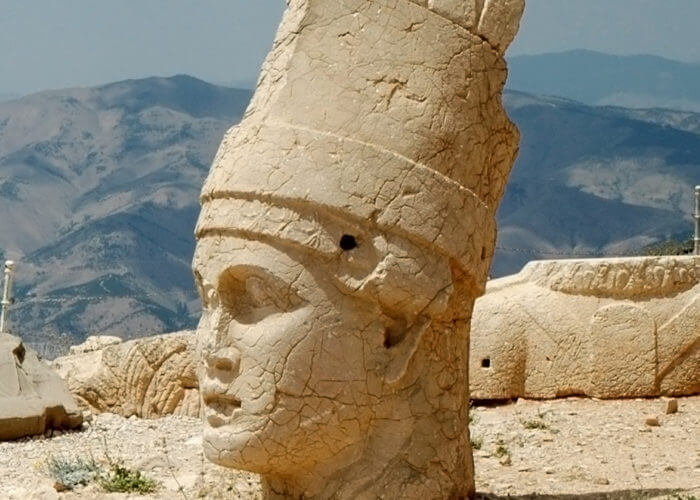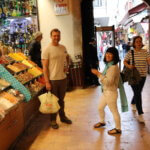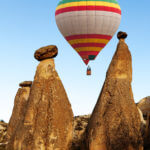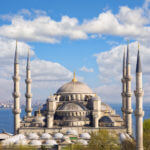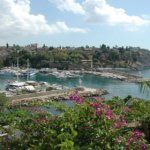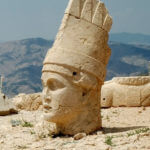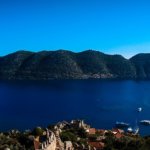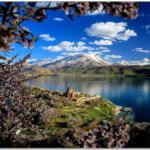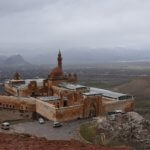Mount Nemrut is the most remarkable ancient site in Turkey is to be found on Mt.Nemrud (2150 m. above sea-level) near the village of Eski Kahta close to Adiyaman, a city in the south-east of the country. The climb up and down again by foot and on horseback makes a long journey, but the fascinating beauty of the monumental sculptures as well as the splendor of the scenery are unrivalled. The district between the Taurus Mountains and the Euphrates was called Kommagene in Greek and Roman times, and it includes the cities of Samosata, Perre, Doliche and Germanikeia Kaisreia as well as Nemrud Dağ. This region, occupied today by the modern cities of Adiyaman, Maras and Gaziantep, has been identified with Kumuhu, the territory comprising the Neo – Hittite kingdom mentioned in Assyrian annals.
Kommagene Kingdom
Kommagene was set up as an independent kingdom about 80 B.C. by Mithradates I Kallinikos during the civil wars that ended the Seleucid Dynasty. The kingdom flourished in the reign of Antiochos I was succeeded by Mithradates II. The Kommagenian Dynasty lasted until A.D. 72, when the region was incorporated in the Roman province of Syria by Vespasian.
Arsameia
Arsameia on the Nymphaios. This city was discovered by Professor Friedrich Karl Dörner of Münster University during his systematic investigations in connection with the Kommagene project. In 1951he found a monumental inscription cut in the rock on the south flank of Eski Kale (Ancient Castle) near Eski Kahta (in Adiyaman) on the River Nymphaios (the present day Kahta Cay). In the inscription ‘’the Great King Antiochos, God, the Righteous, Epiphanes, the Romanophile and Hellenophile, son of King Mithradates Kallinikos and Queen Laodike, daughter of Antiochos Epiphanes ‘’ states that this site was chosen by his father as his ‘’Hierotheseion’’, or sacred last resting-place. The king Antiochos Epiphanes mentioned in the inscription is Antiochos VIII Philometer, the last king of the Seleucid Dynasty. The inscription also discloses that Arsameia on the Nymphaios was founded by Arsames, an ancestor of Antiochos; further that the city had a fortifying wall and contained palaces besides other buildings. Antiochos records that here a common cult of father and son should be established both in his own honour and in memory of his ancestors.
The excavations supervised by Professor Dörner have yielded some very important finds among which was a 3.43 m. – high relief, now re-erected in its original place above the aforementioned monumental inscription. This well-preserved relief, executed half in Parthian and half in Greek iconography but entirely Greek in style (Pls. 109-111), has been thoroughly studied by John Howard Young. It shows King Mithradates Kallinikos shaking hands with Herakles, who in Kommagene also represented Ares and the Persian god Artagnes. The relief must have been carved in the reign of Antiochos I about 50 B.C.
The Roman Bridge
Two or three kilometers south-west of Arsameia, the handsome bridge spanning the Cendere Cay, a branch of the Kahta Cay (the Nymphaios) was erected, according to a Latin inscription on the columns, by four Kommagenian cities in honour of Septimius Severus, his wife Julia Domna and his sons Caracalla and Geta. Four columns originally stood in two pairs on either side of the bridge, but the one set up in honour of Geta is missing. Probably it was removed after Geta was murdered by his brother Caracalla.
The Royal Tumulus
About 10km. south-west of Arsemia on the Nymphaios is a tumulus where the royal womenfolk were buried. The three Doric columns on its southern side are each surmounted by a statue of an animal; one by a lion, another by a bull and the third by an eagle. Since they overlook the Kahta Cay and form part of the view of the tumulus from the top of Nemrud Dag, they also must date from the reign of Antiochos I (63-32 B.C.)
The Tumulus and the Hierotheseion of King Antiochos
Nemrud Dag. As a result of successful research and digs directed since 1953 by Theresa Goell on behalf of the American School of Oriental Research, New Haven, Connecticut, the most striking archaeological site in Turkey has now been systematically examined. The tumulus and the hierotheseion of isolated mountain 2150 m. above sea-level, lying among the Ankar Mountains immediately north-east of Kahta. The tumulus, piled with fist – sized stones, is 50 m. high and 150m. in diameter. It is bounded on the east, west and north by three terraced courts hewn from the living rock. The east court forms the most important ensemble of architectural and sculptural monuments. It is surrounded on the west by colossal statues, on the east by a pyramidal fire altar, and on the north and south by low walls composed of orthostates (upright stone slabs) standing on a long, narrow base. The orthostates overlooking the court on the north were adorned with reliefs depicting the Persian ancestors of Antiochos, while those on the south bore reliefs portraying his Macedonian antecedents. In front of each relief there still stands on the fronts of the orthostates were engraved on the outer faces. The greatly damaged orthostates now lie in small fragments on the ground. Professor Dorner, who assembled and studied these pieces, has established the genealogical trees of Antiochos of Kommagene both on the paternal (Persian) side and on the maternal (Seleucid – Macedonian ). According to his genealogy Antiochos I of Kommagene claims descent through his father Mithradates from Dareios I (522 – 486 B.C.) and through his mother Laodike to Alexander the Great (336 – 323 B.C.). The steps of the pyramidal altar bordering the east side of the eastern court are still partially preserved.
The Colossal Statues
The colossal statues of seated figures overlooking the court on the east terrace are fairly well preserved and reach a height of 8-10 m. These block-like statues recall the very similar portrayals of seated deities to be found at Yesemek, some 50 km. south – west of Gaziantep on the borders of ancient Kommagene. The latter date from the Hittite period and have been systematically investigated by Professor Bahadir Alkim. Each god of Kommagene incorporates several deities, following the principle of syncretism. In this way the Macedonians from the time of Alexander onwards tried to unite the Greeks, Persians and other peoples of the Near East by identifying their various deities with one common type. Inscriptions state that the colossal statues on the east terrace proceeding from left to right are as follows: 1) Appollo – Mithra – Helios – Hermes . 2) Fortuna, or the fertility goddess of Kommagene. 3) Zeus – Oromasdes (Ahuramazda). 4) Antiochos. 5) Herakles – Artagnes – Ares. An eagle and a lion statue stood one on each side of the divinities. The heads of all statues save for that of the goddess of fertility have toppled down and can now be observed lying in the same sequence on the ground. They are exceedingly fine examples of the idealized late Hellenistic style, bearing handsome faces with noble features. The gods wear the Persian tiara and diadem. Zeus and Antiochos have lost the tops of their headdresses. The necks of Antiochos and the other gods are protected from the sun by lappets in the Persian fashion. A crown of fruits adorns the head of Fortuna, who bears a veil as a symbol of womanhood. The sides of the pedestals over- looking the court and the tumulus are engraved with inscriptions giving details of cult procedure, the birthday of the ruler, as well as the prescriptions and laws of his country.
The row of statues representing divinities on the west terrace follows the same sequence. Though the heads of these statues also lie on the ground they are in a better state of preservation. The face of Fortuna on the other terrace is badly eroded but on this terrace is in quite good condition. The heads of Herakles, Zeus and Apollo are also much better preserved than those on the eastern side of the tumulus. Owing to different topographical features the orthostates bearing in reliefs and inscriptions of ancestors on the west terrace are not arranged in the same way as on the east side. The slabs of the Macedonian ancestors of the king are in this case placed opposite the monumental statues, whilst those bearing reliefs of the Persian ancestors are set up on the southern border of the west terrace. In the same way the reliefs in the west court depicting Antiochos shaking hands with several deities are excellently preserved, while the slabs with the same figures on the east terrace are represented by only a few fragments. On the west side can be seen the following hand – shaking scenes: Antiochos and Appoll – Mithra – Helios – Hermes : Antiochos and Zeus – Oromasdes : Antiochos and Herakles – Ares – Artagnes .
The Lion Horoscope
The lion relief in the west court deserves special attention. According to Professor Otto Neugebaure of Brown University, this relief bears astronomical symbols. Nineteen stars seen in the background of the relief and on the lion’s body, a crescent moon on its breast and the conjunction of the corresponding to the Greek word for Jupiter, Mercury and Mars can be interpreted as the date July 7,61 or 62 B.C.this happens to be the date when Antiochos was set on the throne by the Roman general Pompey.
The north terrace took the form of a processional way linking the east and west terraces. Slabs lying on the ground were originally part of a wall 3 m. in height and 80 m. in length. There was an entrance in the middle of the wall giving access to a ramp leading from the valley to the mountain top. This entrance was guarded by the colossal statue of an eagle. Trenches dug into the tumulus indicate that it was piled up on a rocky hill. It is therefore very probable that the bones or ashes of Antiochos I of Kommagene were preserved in a chamber cut in the living rock and covered by the tumulus.

